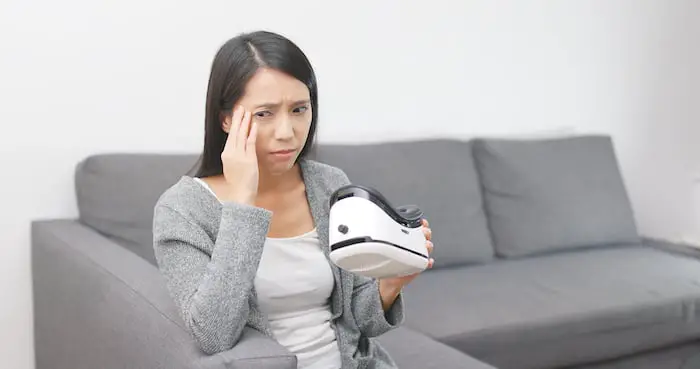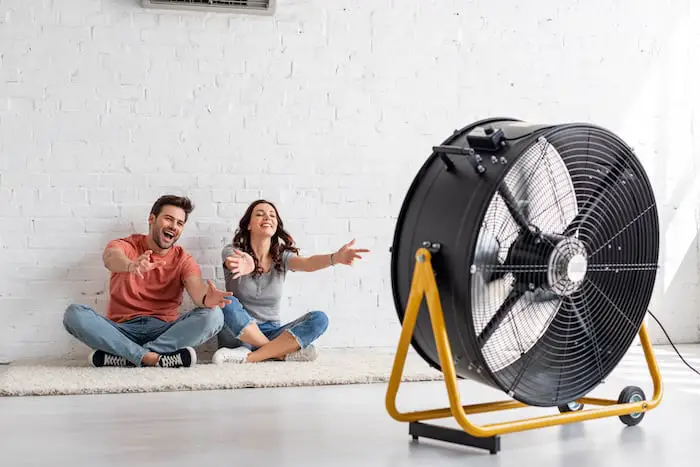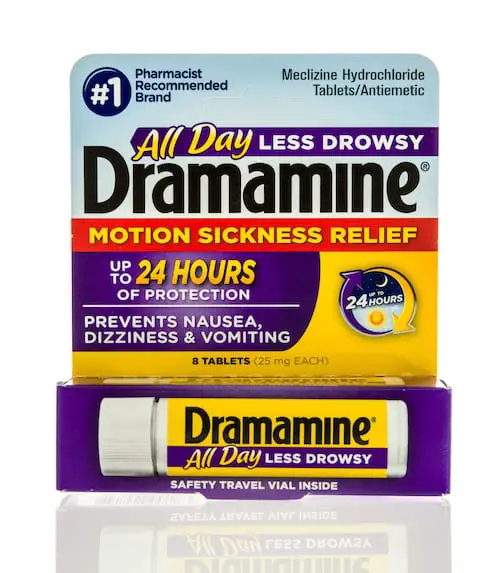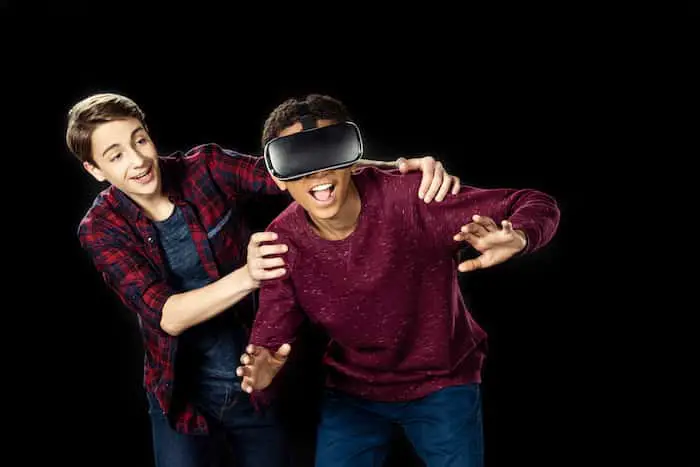You’re in the zone. Your headset is on and you’re gearing up for that last kill.
You hit the button on your jetpack, zoom to the top of the map, look down… and puke.
All over.
It’s an embarrassing situation, but it’s something that happened thousands of times since virtual reality went mainstream a few years ago.
The issue is VR motion sickness.
It affects a decent portion of the population that tries out VR, and it causes unpleasant symptoms.
I wanted to put together this guide to inform you about the topic and just how you can avoid tossing your cookies while playing.
What is Virtual Reality Sickness?

Virtual reality sickness is just like motion sickness, but instead of being exposed to a real-life trigger, you experience the trigger in your headset. Those experiencing VR sickness can have a variety of symptoms, and none of them are all that great. These include nausea, sweating, headache, vomiting, and general discomfort, just to name a few.
Whatever the symptoms, you need to know that VR sickness is a real experience that people have, and it been investigated by medical professionals.
The big question here is, why does VR sickness happen, and what can be done to help alleviate the symptoms?
This is something I’m going to end up looking into today, and hopefully, educate you on the various theories behind the phenomenon and how you can stop from being “that guy or girl”.
Why Does VR Motion Sickness Happen?
Thus far, there hasn’t been a definitive reason why some people get sick while experiencing VR, but there are a few theories.
Sensory Conflict Theory
One very good theory behind the motion sickness is that your body has a series of systems in place that helps with things like balance, locomotion, and such. These systems are naturally in-tune with your real-world environment and are used to the norms of the Earth’s gravity, general physics, and other things we perceive in everyday life.
When we wear VR, we’re transported to a world that doesn’t necessarily play by our rules. We can travel at lightspeed, jump 100 feet at a time, or race around in cars. This all happens despite the fact that you’re either sitting in a chair or standing in a room.
While this virtual world is fooling your eyes and your ears, it may not be doing such a great job of convincing other parts of your body, as they aren’t directly influenced by the technology. This creates a conflict, and if your body doesn’t like what it’s seeing its spew city.
A good example of this explained can be seen below (in 360!):
Postural Instability Theory
Okay, I’m not going to be your mom and tell you to stop slouching, but it’s possible that your posture may cause some of that queasiness you’re feeling in VR.
The idea here is that in nature, finding the right way to posture and balance an animal’s body is crucial, and if that isn’t happening, you’re likely to be uncomfortable or sick.
Once again, when you’re in VR, you have a situation that can alter your natural balance and posture, thereby throwing off your body and making you feel sick.
It’s pretty crazy to think that something so primitive could be the cause of the reason you’re barfing while pretending to be Godzilla, but it is a possibility!
Eye Movement Theory

When you’re in VR, your eyes are taking in a whole world that’s not actually there.
Those images are being displayed on screens, and the refresh rates of these screens (frames per second, or hertz if you’re a nerd like me) needs to be high enough to complete the illusion. With movies and TV, you would generally experience this in 24Hz, 30Hz, or 60Hz, but in VR the higher the framerate the better.
Most headsets have 72Hz as an absolute minimum, with 90Hz considered normal, and some even going up to 120Hz (PSVR). These refresh rates help ensure buttery-smooth movement as you whip your head back to see a goblin about to impale you. If the framerate isn’t constant, or somehow stutters, it can cause strain on your eyes.
Making matters worse, the unnatural ways that your eyes have to move in VR due to the experience once again makes your eyes go wonky, and that could be a key factor in telling the rest of your body “something ain’t right”, causing you to puke.
Evolutionary Theory
The fourth theory (and perhaps craziest) is what’s called the Evolutionary Theory.
The idea behind this one is that our bodies have evolved to have ways to fight against taking in poisons and intoxicants, triggering us to react so that the body can fight back against the toxin.
These responses vary from triggering tiredness to sweating and even puking. The researchers tying this to VR indicate that the technology causes your body to think that it’s somehow intoxicated, setting off queasiness, sweating, and other effects that are unpleasant for you.
I don’t know if this is something I can get behind, but I wanted to let you know some of the leading theories.
Who Gets VR Motion Sickness?
As the research continues, we’re going to continue to learn more about VR motion sickness.
Right now, we have some insights into motion sickness as a whole, and some studies in the 90s ended up giving some insights into simulator sickness, which is closely related.
With the various studies that have been conducted, those most prone to virtual reality motion sickness are:
- Female - Studies have shown that women are more likely to get simulator sickness than men, but the exact cause isn’t known. Some speculate that hormones have something to do with it, while others say that women have a wider field of view than men, which could be a cause.
- Under the age of 21 - Children are most susceptible to virtual reality motion sickness, with those under 12 most likely to puke in VR.
- In poor health - Those who aren’t in great health are more prone to experiencing VR motion sickness. Obviously, if you’re already feeling wonky from having the flu or a cold, it may not be a brilliant idea to go blasting zombies in your headset.
- New to the technology - Those who are new to VR tend to be the ones who puke the most. Interestingly, having a negative experience pushes people away from using VR again, but those who do tend to work their way out of motion sickness.
How to Reduce or Prevent Virtual Reality Motion Sickness?
Even though throwing up because you’re using VR sucks, it’s thankfully not something that has to keep you out of the action. Entrepreneurs have been clamoring to find ways to get you out of the barf bag and into a headset, and some of the methods seem to work pretty well.
Not All Experiences Are for Everyone
Not everyone can ride a rollercoaster without puking, and the same rules apply to VR experiences.
Platforms like Oculus already know this, and they put a comfort section into their apps to help you find the right type of experience.
Comfortable apps will generally keep you in place or prevent you from experiencing too much movement that will make you queasy. More intense apps like racing or dogfighting are likely to induce motion sickness and are flagged as such. If you’re prone to chucking your biscuits, you probably want to keep a close on these categories.
A Fan May Be the Answer

This one sounds like it comes out of the Twilight Zone, but I know of more than a few people that use fans to help them from puking in VR. The reason this seems to work is that it works to convince your body that it is also moving, rather than staying still while the VR world zooms by.
This plays in with the Sensory Conflict Theory mentioned above and has a lot of people that vouch for it.
If this doesn’t work for you, at least you’ll be “cool” like the Fonz, right?
Take a Break

While VR gameplay is immersive and you can find yourself playing for long stretches of time. I myself find that I start “feeling it” the longer I play, and this seems to be the case in terms of motion sickness as well.
One thing that does make me recuperate quickly is taking a break.
This will also help you out if you’re prone to motion sickness, as it pulls you out of the experience making you feel crummy, and it gives your body a chance to reset.
This is probably the best place to start if you want to try and overcome your VR issues.
Consumables May Help
As with most things in life, eating food, medicine, or supplement is rumored to also help with VR sickness. The number of things rumored to work with motion sickness is almost unlimited, here are some of the ingestible items that get the most kudos.
Ginger

Ginger has long been used as a way to treat nausea, and some VR users have claimed that it helps with motion sickness as well.
As someone who hails from the Midwest, I can vouch for ginger ale when I’m not “feeling right”.
Whether or not this translates to virtual reality is another thing altogether, but at the very least you’ll end up having a tasty treat!
Mint

Mint and peppermint have been shown to help ease the digestive process in those who consume it, often calming down upset stomachs.
If you’re in a situation where you think there’s a possibility of getting motion sickness, it may be a good idea to pop in a piece of mint gum or put a peppermint candy in your maw before you put the headset on.
Admittedly, this isn’t a route that I’ve gone with, but it sounds interesting (to say the least).
Dramamine

Dramamine is a medicine that’s often used to treat seasickness in both kids and adults.
The medicine can be purchased over the counter, and you don’t even have to swallow it, as it is also available in little patches that you can stick just behind your ears.
I’ve heard a lot of success stories with Dramamine for VR, as it seems that the same triggers behind seasickness are behind motion sickness.
Marijuana
Okay, I’m not saying you need to be Snoop Dogg, but a lot of VR users say that marijuana helps with virtual reality motion sickness.
Smoking a little bit may end up helping you ward off queasiness, but you’re going to want to make sure you don’t overconsume, otherwise, you may melt into your headset and truly think you’re part of the VR world.
Wearing a Wristband
There are a few wristbands that are available that claim to help with VR motion sickness.
Some of these work by pressing on a pressure point, stimulating the body and keeping you from getting nausea.
Other wristbands have a small electrical current that runs through your hand to help eliminate the puking phenomenon. I’ve never had to use these bands, but I know of a few people who use them to cut down on sickness while riding on boats, and they claim they work.
PC Users: Optimize Your Setup
Those who’re PC master race may have a leg up on the other VR plebs, as they have more control over their VR experience. If you can tailor your setup to run smoothly rather than attempting to max out every small detail, you’re more likely to end up keeping yourself from tossing your cookies all over that nice mechanical keyboard that you annoy everyone with.
Find a Way to Move in Place
If you subscribe to the Movement Conflict Theory, you’re going to want to do something to make it seem like your body is moving in conjunction with your VR experience.
To this end, the fan mentioned above is a good option. If for some reason that doesn’t work for you, some users have claimed that moving around helps a bit. Of course, this would assume you’re using a six degrees of freedom device, as if you try this in three degrees of freedom, you’re likely to puke.
An omnidirectional treadmill or small treadmill have been reported to have worked, but it’s an awfully expensive option to try.
Build Your Tolerance
Think of this like you’re going on Spring Break and you want to build your booze tolerance before you party for a week. You’d start having a couple of drinks, then a day or so later you’d have more, scaling up for a week or two before you leave on your quest. This is something that could theoretically work with VR motion sickness as well.
Instead of slamming bad booze, you’d start off with an app that’s really tame. You’d eventually work your way into experiences that a bit more intense, eventually getting to the point where you’d be able to take on the intense, stomach-turning apps that have sent you my way.
Ask Someone to Chill You Out Before Hand

I don’t put too much stock in this option, but there have been anecdotes of users getting through VR motion sickness by having someone in the room with them telling them that they’re going to be okay before jumping in. This works by having you not psyching yourself out going into the strange space and knowing you have a comforting presence right by your side.
Come Out and Chill Out
If you do end up having a nice VR experience where you don’t end up nauseous, you should take note of what went well for you, so that you can try that again for your next session.
You also may want to take a bit of time to sit and let your body recover, so that you don’t overload with stimuli and get sick when you take your headset off.
Learning About Motion Sickness Treatment
There isn’t a whole ton of information related to VR motion sickness, I did find this informative video that gives up some good information on motion sickness as a whole, and just what you can do to try and avoid it.
So, What is Being Done to Combat VR Motion Sickness?
As we’ve noted above, there have been a bunch of different studies looking into the issue, but there’s also a bunch of research going into combatting VR motion sickness as well.
Researchers around the world are undergoing multiple studies with a wide set of patients to try to get a better grasp of how VR can be a better experience for everyone.
Some of the studies that have been conducted or are currently ongoing include:
Estimating the sensorimotor components of cybersickness – University of Waterloo
A comparative study of cybersickness during exposure to virtual reality and “classic” motion sickness: are they different? – Alireza Mazloumi Gavgani, Frederick R. Walker, Deborah M. Hodgson, and Eugene Nalivaiko
The Neurophysiology and Treatment of Motion Sickness – Andreas Koch, Ingolf Cascorbi, Martin Westhofen, Manuel Dafotakis, Manuel Dafotakis, Sebastian Klapa, and Johann Peter Kuhtz-Buschbeck.
Resources and Further Reading
If you’re looking to read more into VR motion sickness but don’t want to dig into the medical research papers above, you can find some great resources on Virtual Reality motion sickness below:
- Virtual reality sickness - Wikipedia
- What is VR Sickness? - Beanz Magazine
- Virtual reality has a motion sickness problem - Science News
- Posture could explain why women get more VR sickness than men - New Scientist

